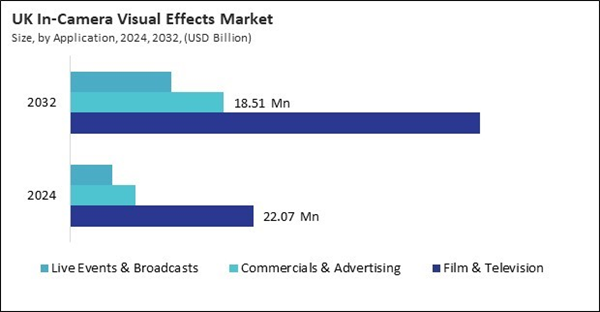The UK market dominated the Europe In-Camera Visual Effects Market by country in 2024, and is expected to continue to be a dominant market till 2032; thereby, achieving a market value of $109.2 million by 2032. The Germany market is exhibiting a CAGR of 11.1% during 2025-2032. Additionally, the France market is expected to experience a CAGR of 13% during 2025-2032.
The applications of in-camera VFX are diverse, spanning multiple sectors beyond traditional film production. In film and television, these effects enable directors to create fantastical environments, realistic creatures, or complex action sequences without relying solely on expensive post-production CGI. For example, the groundbreaking work done by Industrial Light & Magic (ILM) on The Mandalorian leveraged LED volume stages to project photorealistic backgrounds in real time, allowing actors and cameras to interact dynamically with digital environments.
In commercial advertising, in-camera VFX is used to create eye-catching visuals that blend live action with real-time digital augmentation, improving engagement without excessive editing time. Brands are increasingly incorporating AR-driven in-camera effects to showcase products in innovative ways, as seen in campaigns by companies like Nike and PepsiCo, where live augmented elements help convey dynamic product stories during shoots.
Germany’s in-camera visual effects market is strongly supported by its world-class film production hubs such as Berlin, Munich, and Cologne, which are home to renowned studios and post-production facilities. The country’s film and television industry benefits from robust government incentives, including the German Federal Film Fund (DFFF), which offers financial support encouraging innovative production technologies like in-camera VFX. Germany has a growing ecosystem of OEMs, including ARRI, which is internationally respected for its cutting-edge camera systems and lighting equipment crucial for virtual production and in-camera effects.
Italy’s in-camera visual effects market is closely intertwined with its rich cinematic history and a growing modern digital production landscape. While Italy traditionally emphasized location shooting and practical effects, recent government initiatives through agencies like the Italian Ministry of Culture have encouraged digitization and technology adoption within the audiovisual industry. Studios in Rome, Milan, and Turin have begun investing in LED volume stages and real-time rendering technologies, driven by demand from domestic productions and an increase in international co-productions. Italy’s thriving fashion and automotive sectors also contribute to the market by demanding advanced visualization tools and immersive storytelling techniques, fueling interest in in-camera effects for commercials and promotional content.
Spain’s in-camera visual effects market is expanding rapidly, supported by vibrant film industries in Madrid and Barcelona and attractive government incentives such as Spain’s tax rebate programs for film and audiovisual production. The Spanish government’s commitment to fostering creative industries and digital innovation through the Ministry of Culture and Sports has encouraged studios to adopt cutting-edge in-camera VFX technologies. Spain benefits from an increasing number of international productions filming in the country, attracted by cost advantages and the availability of skilled VFX professionals. Hence, Italy, and Spain are accelerating in-camera VFX adoption across Europe, blending rich cinematic traditions with modern digital innovation to enhance global competitiveness.
List of Key Companies Profiled
- Wētā FX Ltd.
- Sony Corporation
- Samsung Electronics Co., Ltd. (Samsung Group)
- Epic Games, Inc.
- Double Negative Limited (DNEG) (Prime Focus Ltd.)
- NEP Group, Inc. (The Carlyle Group Inc.)
- The Framestore Limited
- ARRI GmbH (Stahl Holdings B.V.)
- NantStudios, LLC
- Megapixel
Market Report Segmentation
By Component
- Hardware
- Software
- Services
By Application
- Film & Television
- Commercials & Advertising
- Live Events & Broadcasts
By Technology
- LED Volume Technology
- Real-Time Rendering Engines
- Camera Tracking Systems
By Offering
- Production
- Pre-Production
By Country
- Germany
- UK
- France
- Russia
- Spain
- Italy
- Rest of Europe
Table of Contents
Companies Mentioned
- Wētā FX Ltd.
- Sony Corporation
- Samsung Electronics Co., Ltd. (Samsung Group)
- Epic Games, Inc.
- Double Negative Limited (DNEG) (Prime Focus Ltd.)
- NEP Group, Inc. (The Carlyle Group Inc.)
- The Framestore Limited
- ARRI GmbH (Stahl Holdings B.V.)
- NantStudios, LLC
- Megapixel









